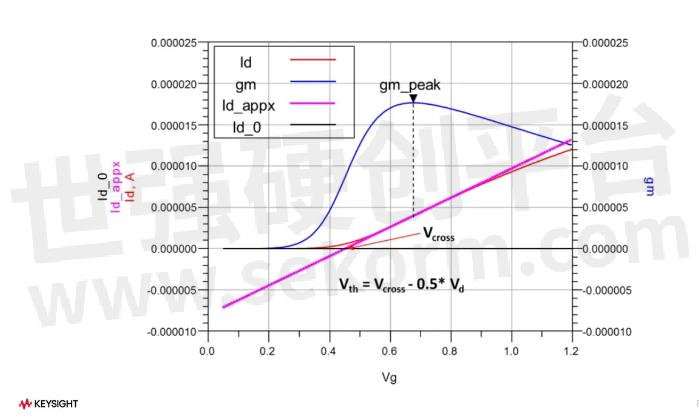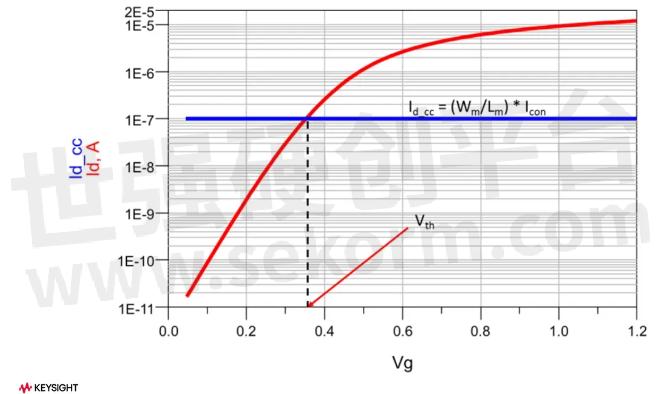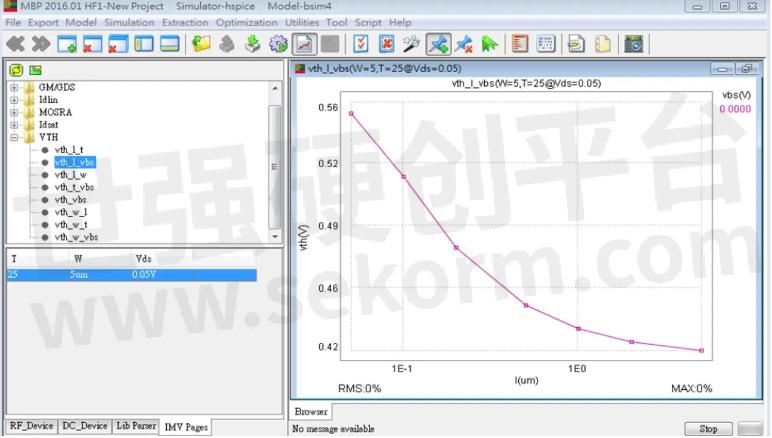MOSFET Threshold Voltage Extraction: How to Get Power Management Right from the Beginning

The endurance of your smartphone battery amidst your relentless multitasking is nothing short of an engineering marvel. The increasing longevity of batteries highlights the delicate balance circuit designers and modeling engineer strike in power management. With electronic devices becoming ubiquitous, from mobile gadgets to servers and networking equipment, the race intensifies for power-efficient, scalable semiconductor devices. These essential components must minimize power consumption while fitting into densely packed integrated circuits.
Metal-Oxide Field-Effect Transistors, or MOSFETs, stand out in this progressive trajectory.
Developed in the 1960s, these transistors have become a mainstay in electronic devices, thanks to their power efficiency, scalability, and manufacturability. In fact, your smartphone might carry billions of nanoscale MOSFETs.
For designers aiming to optimize power management, accurate modeling of MOSFETs – the full characterization of the device performance by a mathematical formula and their fitting parameters – is essential.
Threshold voltage: A critical parameter for MOSFET modeling
The threshold voltage (Vth) is a crucial parameter to extract for accurate MOSFET modeling. Over the decades, experts have fine-tuned the definition of Vth. It means the gate voltage where a MOSFET transitions from weak to strong inversion. In simple terms, Vth is the voltage where conduction of current begins. As devices become more compact, zeroing in on the precise Vth has become imperative for ensuring optimal functionality and energy efficiency in both digital and analog applications.
However, finding a definitive threshold in the drain current (ID) vs. gate-source voltage (VGS) characteristic relationship is no easy feat, due to the continuous nature of the physical phenomena at play. This challenge has given rise to numerous methods to extract the value of threshold voltage. This article will help properly understand these methods and influential factors to ensure accurate and consistent Vth extraction.
How to extract the threshold voltage
There are two popular methods for extracting the threshold voltage (Vth). Depending on the device and application, these methods offer varying degrees of precision and relevance.
Linear Extrapolation Method (ELR)
The linear extrapolation method (ELR) determines Vth by locating the gate voltage (Vg) axis intercept of the linear extrapolation of the drain current (Id) –Vg curve at its point of maximum transconductance (gm). The value of Vth is calculated by subtracting Vd/2 to Vg intercept point to minimize the effect of different values of drain voltage (Vd). As shown in Figure 1, there are four key steps:
1. Find gm_peak
2. Calculate Id_appx based on Id at gm_peak
3. Find Vcross based on Id_appx
4. Substract Vcross by Vd/2 to get the value of Vth

Figure 1. Calculating the threshold voltage using Linear Extrapolation Method (ELM)
However, the ELR method has certain limitations. Mobility degradation effects and the impact of significant source and drain series parasitic resistances can skew the Id-Vg curve, thereby rendering the extracted threshold voltage value imprecise.
Constant Current Method (CC)
The constant-current method (CC) evaluates the threshold voltage as the value of the gate voltage, Vg, corresponding to a given arbitrary constant drain current (Id). Usually, drain voltage (Vd) is less than 100mV to bias the transistor at a linear region. Both source and body nodes are connected to the ground.
Id is equal to (Wm/Lm) * Icon, where Wm and Lm are the mask channel width and length respectively. Icon is an arbitrary value. While a typical value of Icon is 1e-7, it may be different for different process nodes. Despite the simplicity of the CC method, the outcome heavily depends on the assigned drain current value Icon. This selection can introduce significant variations in the extracted threshold voltage.

Figure 2. Extracting Vth using Constant Current Method
Key factors affecting the threshold voltage
Variations in threshold voltage (Vth) can have significant implications for the performance and reliability of the devices. Several factors, both internal and external, can influence the threshold voltage of a MOSFET.
Oxide layer thickness
The type of oxide and the thickness of the layer can alter the threshold voltage. A thinner oxide layer results in a reduced threshold voltage, and vice versa.
Temperature
Although not directly related, temperature variations do impact threshold voltage. For instance, a 30°C change can change the threshold voltage by about 500mV.
Random dopant fluctuation (RDF)
RDF entails reducing random dopant fluctuation by minimizing dopant density. This can alter MOSFET characteristics, including the threshold voltage.
Considerations for precise Vth extraction
Getting Vth of a MOSFET right is like making sure the brick in the foundation of your house is solid. Here are some key considerations for ensuring an accurate Vth extraction.
Maintaining consistent condition
The bedrock of any scientific measurement is consistency. This means maintaining uniform experimental conditions when extracting Vth. Changes as subtle as temperature variations or swapping out equipment can introduce discrepancies in your readings.
Averaging results
To increase the reliability and accuracy of Vth extraction, perform multiple measurements and calculate an average.
Staying updated with the latest tools
The precision and accuracy of measurement tools have improved over the years. Tools like Keysight's PathWave Device Modeling solution offer modern features designed to improve modeling accuracy and time-to-release. For instance, with automated measurements, you can not only ensure accuracy but also save valuable time.
Consider the impact of device geometry and scaling
As MOSFETs get scaled down, they are more susceptible to short-channel effects. These effects can have a significant influence on the threshold voltage. So it’s essential to consider these effects when extracting Vth for compact electronic devices.
Choosing a reliable partner
Ever found yourself scratching your head over Vth extraction or wishing there was an easier way to compare results from different methods?
Keysight's PathWave Model Builder (MBP) is a comprehensive model generation solution designed to take the guesswork out of the threshold voltage extraction for MOSFETs. Its built-in extraction packages are tailored for standard industry models, and we’ve even included a customizable modeling strategy interface to ensure you have the flexibility you need.

Figure 3. Vth vs. Length in PathWave Model Builder (MBP)
Inside MBP, you'll find both CC and ELR methods smoothly integrated into the libraries and are just a click away on the IMV (InterMediate Variable) page.
In the realm of power electronics, the significance of device modeling becomes increasingly paramount. As devices push the boundaries of efficiency and miniaturization, understanding the intricacies of MOSFET threshold voltage extraction is not just an academic exercise but a necessity. Accurate device modeling forms the bedrock of efficient power electronic systems, ensuring that components work optimally and synergistically. As we advance further into an era dominated by ultra-low-power devices, leveraging precise methodologies and state-of-the-art tools for MOSFET modeling will be the cornerstone for groundbreaking innovations in power electronics.
- +1 Like
- Add to Favorites
Recommend
- Keysight Introduces PathWave Design 2024 with Automation and Collaboration Support for Enterprise EDA Workflows
- Keysight PathWave System Design 2023 Software Accelerates RF System Design and Digital Mission Engineering Workflows for 5G Non-Terrestrial Networks
- Keysight PathWave Software Selected by Menlo Micro to Reduce Design Cycle for New Radio Frequency Microelectromechanical Switch
- Keysight Introduces PathWave ADS 2024 to Accelerate 5G mmWave Design and Pioneer 6G Development
- 5 Quick Tips You Should Know as a New PathWave BenchVue User
- Boosting Your Manufacturing Analytics System with Keysight’s Pathwave Manufacturing Analytics (PMA)
- Keysight‘s UXA Signal Analyzers and PathWave X-Series Measurement Applications for 5G NR Base Station Transmit Power Tests
- Keysight Expands eCommerce Offering; Adds New Software Bundles
This document is provided by Sekorm Platform for VIP exclusive service. The copyright is owned by Sekorm. Without authorization, any medias, websites or individual are not allowed to reprint. When authorizing the reprint, the link of www.sekorm.com must be indicated.














































































































































































































































































































































































































































































































































































































































































































































































































































